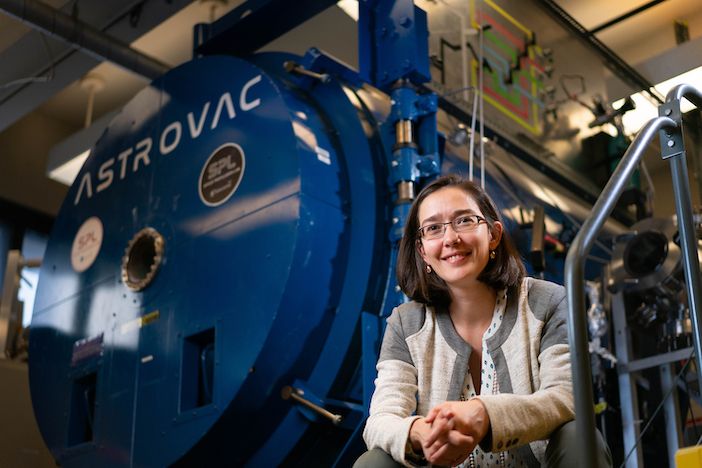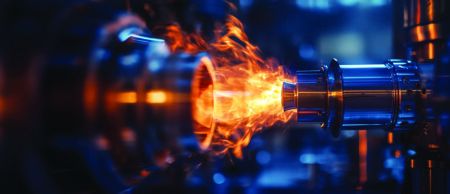At the height of a thunderstorm, the tips of cell towers, telephone poles, and other tall, electrically conductive structures can spontaneously emit a flash of blue light. This electric glow, known as a corona discharge, is produced when the air surrounding a conductive object is briefly ionized by an electrically charged environment.
For centuries, sailors observed corona discharges at the tips of ship masts during storms at sea. They coined the phenomenon St. Elmo’s fire, after the patron saint of sailors.
Researchers have found that a corona discharge can strengthen in windy conditions, glowing more brightly as the wind further electrifies the air. This wind-induced intensification has been observed mostly in electrically grounded structures, such as trees and towers. Now aerospace engineers at MIT have found that wind has an opposite effect on ungrounded objects, such as airplanes and some wind turbine blades.
In some of the last experiments performed in MIT’s Wright Brothers Wind Tunnel before it was dismantled in 2019, the researchers exposed an electrically ungrounded model of an airplane wing to increasingly strong wind gusts. They found that the stronger the wind, the weaker the corona discharge, and the dimmer the glow that was produced.
The team’s results appear in the Journal of Geophysical Research: Atmospheres. The study’s lead author is Carmen Guerra-Garcia, an assistant professor of aeronautics and astronautics at MIT. Her co-authors at MIT are Ngoc Cuong Nguyen, a senior research scientist; Theodore Mouratidis, a graduate student; and Manuel Martinez-Sanchez, a post-tenure professor of aeronautics and astronautics.
Electric friction
Within a storm cloud, friction can build up to produce extra electrons, creating an electric field that can reach all the way to the ground. If that field is strong enough, it can break apart surrounding air molecules, turning neutral air into a charged gas, or plasma. This process most often occurs around sharp, conductive objects such as cell towers and wing tips, as these pointed structures tend to concentrate the electric field in a way that electrons are pulled from surrounding air molecules toward the pointed structures, leaving behind a veil of positively charged plasma immediately around the sharp object.
Once a plasma has formed, the molecules within it can begin to glow via the process of corona discharge, where excess electrons in the electric field ping-pong against the molecules, knocking them into excited states. In order to come down from those excited states, the molecules emit a photon of energy, at a wavelength that, for oxygen and nitrogen, corresponds to the characteristic blueish glow of St. Elmo’s fire.
In previous laboratory experiments, scientists found that this glow, and the energy of a corona discharge, can strengthen in the presence of wind. A strong gust can essentially blow away the positively charged ions, that were locally shielding the electric field and reducing its effect — making it easier for electrons to trigger a stronger, brighter glow.
These experiments were mostly carried out with electrically grounded structures, and the MIT team wondered whether wind would have the same strengthening effect on a corona discharge that was produced around a sharp, ungrounded object, such as an airplane wing.
To test this idea, they fabricated a simple wing structure out of wood and wrapped the wing in foil to make it electrically conductive. Rather than try to produce an ambient electric field similar to what would be generated in a thunderstorm, the team studied an alternative configuration in which the corona discharge was generated in a metal wire running parallel to the length of the wing, and connecting a small high-voltage power source between wire and wing. They fastened the wing to a pedestal made from an insulating material that, because of its nonconductive nature, essentially made the wing itself electrically suspended, or ungrounded.
The team placed the entire setup in MIT’s Wright Brothers Wind Tunnel, and subjected it to increasingly higher velocities of wind, up to 50 meters per second, as they also varied the amount of voltage that they applied to the wire. During these tests, they measured the amount of electrical charge building up in the wing, the current of the corona and also used an ultraviolet-sensitive camera to observe the brightness of the corona discharge on the wire.
In the end, they found that the strength of the corona discharge and its resulting brightness decreased as the wind increased — a surprising and opposite effect from what scientists have seen for wind acting on grounded structures.
Pulled against the wind
The team developed numerical simulations to try and explain the effect, and found that, for ungrounded structures, the process is largely similar to what happens with grounded objects — but with something extra.
In both cases, the wind is blowing away the positive ions generated by the corona, leaving behind a stronger field in the surrounding air. For ungrounded structures, however, because they are electrically isolated, they become more negatively charged. This results in a weakening of the positive corona discharge. The amount of negative charge that the wing retains is set by the competing effects of positive ions blown by the wind and those attracted and pulled back as a result of the negative excursion. This secondary effect, the researchers found, acts to weaken the local electric field, as well as the corona discharge’s electric glow.
“The corona discharge is the first stage of lightning in general,” Guerra-Garcia says. “How corona discharge behaves is important and kind of sets the stage for what could happen next in terms of electrification.”
In flight, aircraft such as planes and helicopters inherently produce wind, and a glow corona system like the one tested in the wind tunnel could actually be used to control the electrical charge of the vehicle. Connecting to some prior work by the team, she and her colleagues previously showed that if a plane could be negatively charged, in a controlled fashion, the plane’s risk of being struck by lightning could be reduced. The new results show that charging of an aircraft in flight to negative values can be achieved using a controlled positive corona discharge.
‘’The exciting thing about this study is that, while trying to demonstrate that the electrical charge of an aircraft can be controlled using a corona discharge, we actually discovered that classical theories of corona discharge in wind do not apply for airborne platforms, that are electrically isolated from their environment,” Guerra-Garcia says. “Electrical breakdown occurring in aircraft really presents some unique features that do not allow the direct extrapolation from ground studies.”
This article was originally published by MIT and can be viewed here.





